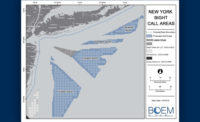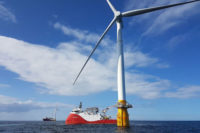As East Coast Offshore Wind Market Booms, More Regional Links Eyed

At NYC networking forum, New Jersey Gov. Phil Murphy announced a new state registry to link offshore wind developers and supply chain participants.
PHOTO BY Debra K. Rubin for ENR

At NYC forum, New Jersey Gov. Phil Murphy (previous photo) announced outreach to industry participants.
PHOTO BY DEBRA K. RUBIN/ENR


Offshore wind energy development in the U.S. has yet to see its first commercial-scale project built, but prospects in the power-short, population-dense Eastern seaboard are gaining huge momentum as more states push ocean wind to source greener power and job growth, according to a new market analysis by the University of Delaware and an enthusiastic gathering of 1,400 current and potential sector participants at an April 9 networking forum in New York City.
Expanding state commitments and falling development costs buoyed attendees, but they voiced concerns about building supply chains, staging areas and grid links fast enough.
Buildout
The burgeoning U.S. offshore wind industry, projected to generate nearly 19 GW of power in seven East Coast states by 2030, “presents a nearly $70-billion [capacity-expansion] revenue opportunity to businesses,” says the March 26 university white paper, touted as a “first-of-its-kind analysis.”
The report quantifies about $68.2 billion in supply chain contracting prospects for forecasted Atlantic seaboard offshore wind procurements. That buildout includes some 1,700 offshore wind turbines and towers worth $29.6 billion; 1,750 turbine and substation foundations at $16.2 billion and more than 5,000 miles of power cables, projected at $10.3 billion.
The study also details rising state wind mandates, led by New York at 9 GW by 2035.
By 2030, New Jersey aims for 3.5 GW, Massachusetts 3.2 GW, Connecticut 2 GW, Maryland 1.2 GW, Rhode Island 1 GW and Virginia 12 MW.
“America’s offshore wind industry is taking off and what people see now is just the tip of the iceberg,” said study author and academic Stephanie McClellan. “States and industry suppliers are leading the way and eager for clarity on the path ahead.”
The U.S. will contribute 20% of global wind power by 2030, according to Liz Burdock, president and CEO of the Business Network for Offshore Wind, which hosted the event. While noting the dominance of Europe’s more developed offshore wind market, “the U.S. will forge its own path,” she said.
Speakers noted Maryland legislators’ April 8 approval of a bill that would require an added 1.2 GW of offshore wind by 2030, with project applications open Jan. 1, although Gov. Larry Hogan (R) has not yet signed the legislation.
New Jersey Gov. Phil Murphy (D), who has moved quickly since taking office in early 2018 to resurrect the state’s dormant offshore wind commitment, told attendees the state will announce the winner of its first 1,100-MW project by June 30. “We’re not just looking at zero-carbon benefits, it’s the right thing for us to do economically,” he said, predicting creation of “4,000 high-skilled union jobs.”
Murphy also announced a state-run free online registry for New Jersey-based suppliers. “Our goal is to have 650 firms in the database in coming months,” he said.
Political Will
New York’s first major offshore wind procurement, for 800 MW, received 18 bids, a record for a U.S. offshore wind project, said New York State Energy Research and Development Authority (NYSERDA) Chairman Richard Kauffman. It is set for award in May.
Steve Dayney, who heads the North America offshore wind unit of European giant Siemens Gamesa Renewable Energy, said there’s “no question the technology exists today to get us to 100% clean energy” if supported by political will and new ways to “industrialize” component fabrication and ocean installation.
Lars Peterson, CEO of Vineyard Wind, which is developing an 800-MW array of 84 turbines off the Massachusetts coast that is the utility-scale project farthest along, told attendees that the project is "on track," with financing set to close at year-end, construction to start next year and blades spinning by 2022.
The project, backed by Danish and Spanish developers, earlier this month inked a 20-year deal with the state Dept. of Public Utilities to supply power at 8.9 cents per kilowatt-hour, which is less than Canadian hydropower and could save ratepayers up to $1.3 billion over that timeframe, according to one online report.
"We took the position that we want to get in early," he told attendees. "We may not make all the margins but we've creates a position. It's a well guarded secret how to do this without a supply chain." But he added, "I see some well positioned companies."
Peterson says expiration this year of key federal tax credit incentives is a key schedule driver. "We need to hit certain milestones but I'm confident we'll be where we need to be at the end of the year," said Peterson.
The project, set to have 9.5-MW turbines, will use a site in New Bedford, Mass, for turbine staging and pre-assembly, said Peterson, who added that it also will have the offshore wind sector's first project labor agreement.
While building trades unions have long supported fossil fuel and oil and gas project interests, trades such as the operating engineers and electrical workers union were among the offshore wind forum's attendees.
Said one developer attendee, "we don't have enough people to meet needs now. Some of our suppliers need 200 welders. That's tough when a community college only graduates 30."
States are furiously seeking new land space for offshore wind support, with New York committing $200 million to port infrastructure and Massachusetts set to redevelop 308 acres of the Brayton Point coal-fired power plant in Somerset, which had been New England's largest such facility and will be imploded on April 27.
But Tim Sullivan, CEO of the New Jersey Economic Development Authority, cautioned about the “public sector impulse to over design ports” for early projects.
New Connections
Even as states compete to meet offshore wind commitments, sector participants emphasized more cross-border cooperation.
“How each state promotes our collective interests will guide how successful we all are,” said Siemens’ Dayney.
Other attendees called for governments to collaborate on design and permitting of an integrated offshore wind grid, similar to what some European nations are beginning to advance.
Gil Quinones, CEO of the New York Power Authority, told attendees that state power agencies are soon to release a study commissioned by Gov. Andrew Cuomo on offshore wind transmission approaches in the UK, Germany, Holland and Denmark. "It looks at site development, transmission design, ownership and onshore systems," he said.
NYSERDA CEO Alicia Barton said New York could invest in out-of-state assets to meet its goal and is “not afraid of working with our neighbors.”






